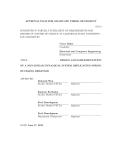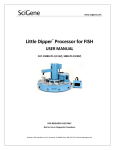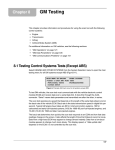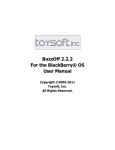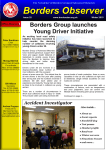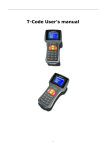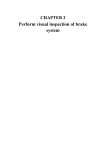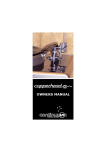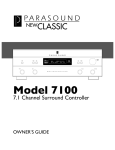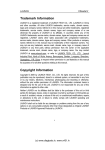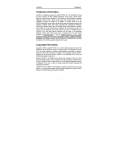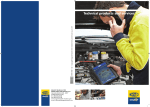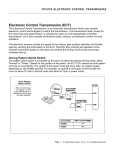Download Toyota, Lexus, Honda and Proton Vehicle - Snap
Transcript
SEE APPLICABLE COVERAGE SHEETS FOR VEHICLE APPLICATIONS Toyota, Lexus, Honda and Proton Vehicle Communication Manual July 2010 Use in conjunction with the applicable Scanner User’s Reference Manual and Diagnostic Safety Manual. Vehicle Identification Before operating this unit, please read this manual and any applicable Scanner User’s Manual. Safety Notices..................................... Refer Diagnostic Safety Manual Quick Reference Contents Listing .... page 5 Using the Scanner Module ................ Refer to relevant User's Manual for more information Vehicle Identification Toyota, Lexus, Honda and Proton Vehicle Communication Manual July 2010 BEFORE OPERATING THIS UNIT, PLEASE READ THIS MANUAL CAREFULLY, ALSO PAY PARTICULAR ATTENTION TO THE SAFETY PRECAUTIONS IN THIS MANUAL AND THE DIAGNOSTIC SAFETY MANUAL. Vehicle Identification The information, specifications, and illustrations in this manual are based on the latest information available at the time of publication. The SCANNER manufacturer and the vehicle manufacturers reserve the right to make equipment changes at any time without notice. Copyright © 2010 Snap-on Technologies Inc. Vehicle Identification Quick Reference Contents Detailed Contents are at the beginning of each part Part 1 — Vehicle Identification..............................................................6 Gives you general information on vehicle identification. Information on SCANNER startup troubleshooting also is included. Part 2 — Vehicle Connection and Diagnostics...................................10 Honda........................................................................................................... 12 Proton........................................................................................................... 26 Toyota/Lexus................................................................................................ 32 Appendix B – Vehicle Does Not Communicate With SCANNER........54 General Note For All Vehicles All SCANNER and Reference Manual directions are as if the operator is standing at the back of the vehicle facing forward. Vehicle Identification Part 1 - Vehicle Identification Contents Vehicle Identification..............................................................................6 Entering the Vehicle Identification........................................................7 System Selection....................................................................................8 SCANNER Connection Message.............................................................8 Vehicle Identification After you select the software, the SCANNER then requires you to enter the vehicle ID into the SCANNER, this done by selecting the manufacturer, the year of the vehicle, model and engine displacement. Pressing N at any point in the first few steps lets you back up to the previous step to correct a choice. Pressing N at the final step will return to the start of the identification process. ‘AUSTRALIA’ is for vehicles that are manufactured for the Australian market and ‘USED IMPORTS’ refers to vehicles that were originally sold new in Japan and have since been exported to other countries, including Australia and New Zealand. The SCANNER does not list every model that is available but does cover the more popular vehicles that are available. CAUTION: Although every effort has been made to provide accurate information, due to the many models available and the lack of information available for these vehicles the information that is contained in the SCANNER for these Used Import vehicles may not always be accurate for the particular model being tested. Vehicle Identification Entering The Vehicle Identification After you select the vehicle manufacturer, the screen displays the following message (example): SELECT MODEL YEAR MODEL: VEHICLE: 1983 ENGINE: Move the thumbpad or thumbwheel up or down until the correct year for the vehicle you are testing is displayed. Then press Y to enter the model year. The display now shows the model year that you selected in the previous step and asks you to select the model name: SELECT MODEL TYPE MODEL: CAMRY VEHICLE: 1995 ENGINE: Move the thumbpad or thumbwheel up or down and press Y to select the model name. The display now shows the model name that you selected in the previous step and asks you to select the engine displacement by pressing the thumbpad up and down to the correct engine, some vehicles may only have one choice: SELECT ENGINE DISPLACEMENT MODEL: CAMRY VEHICLE: 1995 ENGINE: SCROLL TO SELECT ENGINE Move the thumbpad or thumbwheel up or down and press Y to select the engine displacement. The display now shows the engine that you selected in the previous step. Transmission and Air Conditioning Information At the end of vehicle identification, the screen may display the complete model and engine identification, similar to this: SELECT VEHICLE OPTIONS: > A/T WITH A/C A/T WITHOUT A/C M/T WITH A/C M/T WITHOUT A/C Vehicle Identification Scroll arrow to select correct option of vehicle being tested and press Y. NOTE: A/T = Automatic Transmission M/T = Manual Transmission A/C = Air Conditioning If the identification is correct, press Y to store the identification in memory. If the identification is not completely correct, press N to return to the start of the identification steps. System Selection For some vehicles, the SCANNER provides engine and transmission test capabilities. After you press Y to store the identification for these vehicles, the screen will display this message: SELECT SYSTEM ENGINE AUTO TRANS ANTI-LOCK BRAKES AIRBAG (SRS) Move the thumbpad or thumbwheel up or down to move the cursor to the desired system and press Y. The above display does not appear for vehicles without transmission tests. SCANNER Connection Message After you press Y to store the vehicle identification or after you select the engine or transmission system for testing, the SCANNER display tells you how to connect the SCANNER to the vehicle. For example: CONNECT DL-17 ADAPTER WITH S-9 KEY TO 17-PIN CONNECTOR UNDER RH DASH OR ON LOWER RH DASH FACIA. PRESS Y TO CONTINUE. OK TO RELEASE BUTTON. After the SCANNER is connected to the vehicle, press Y to proceed to the MAIN MENU. Vehicle Identification PAGE INTENTIONALLY LEFT BLANK Vehicle Connection & Diagnostics Part 2 — Vehicle Connection and Diagnostics Contents Connecting the SCANNER to the vehicle ........................................ 11 Special Notes on Graph Mode ......................................................... 11 Note on Functional Tests .................................................................. 11 Honda – . ............................................................................................ 12 Connector Types . ............................................................................. 14 Engine ............................................................................................... 16 Automatic Transmission ................................................................... 20 ABS ................................................................................................... 22 SRS – Airbag . ................................................................................... 24 Proton –............................................................................................... 26 Connector Types . ............................................................................. 27 Engine ............................................................................................... 28 Automatic Transmission ................................................................... 30 Toyota and Lexus – . .......................................................................... 32 Special Notes . .................................................................................. 34 Connector Types................................................................................ 37 Engine................................................................................................ 39 Automatic Transmission.................................................................... 46 ABS ................................................................................................... 50 SRS – Airbag . ................................................................................... 52 Used Imports Airbag only . .......................................................... 53 10 Vehicle Connection & Diagnostics Connecting the SCANNER to the Vehicle This section of the manual gives you drawings of the vehicle diagnostic connectors and tells you which SCANNER adapter to use. The carmakers are listed alphabetically for quick-reference. After you identify the vehicle the SCANNER display then tells you where to find the diagnostic connector and which vehicle adapter to use. CAUTION: Ensure vehicle identification as entered on the screen is same as the vehicle connected to the SCANNER. Ensure SCANNER adaptor is connected to correct vehicle pins as failure to observe above can damage the diagnostic equipment and the cost of repairs is not covered by warranty. Note on Functional Tests Functional tests are not applicable to Ethos software. Special Notes on Graph Mode Note that not all vehicle systems will be able to be displayed in the Graph Mode due to the communication type. It may also take several attempts to establish communication in Graph Mode. This is not a fault of the scan tool or the vehicle. 11 Honda Honda CAUTION FOR ABS AND SRS SYSTEMS Before attempting any repairs on vehicles fitted with ABS or SRS Airbag, systems observe all precautions the manufacturer specifies for these systems. Honda Australia Vehicles Honda Australia vehicles are vehicles that are produced to be sold as new on the Australian market. When selecting a vehicle ID on the SCANNER ensure the correct initial selection is made: HONDA – AUSTRALIA. Used Import Vehicles Used Import vehicles are vehicles that were sold new in Japan and have since been exported to other countries including Australia and New Zealand. The SCANNER does not list every model that is available but does cover the more popular vehicles that are available. When selecting a vehicle ID on the SCANNER ensure the correct initial selection is made: HONDA – USED IMPORTS. CAUTION: Although every effort has been made, due to the many models available and the lack of information available for these vehicles the information that is contained in the SCANNER for these Used Import vehicles may not always be accurate for the particular model being tested. Entering initial vehicle ID When entering the initial vehicle identification ensure you have first selected the correct data base for the vehicle being tested, that is whether it is a Honda Australia vehicle or a Honda Used Import vehicle. If you are unsure about a vehicle’s origin check the compliance plates on the vehicle. Note that Honda Australia vehicles are not manufactured in Australia but were sold as new vehicles in Australia and comply with Australian vehicle design rules. 12 Honda SCANNER Communication Types The SCANNER supports live Codes and Data for Engine only on most 4 cylinder models that support live data. Live data has been available on most Honda engines since 1992. All other Engines are Manual Code Read. Automatic Transmission’s, ABS and SRS systems are Manual Code Read only. The SCANNER provides on screen instructions on how to retrieve the codes for these systems. Refer to the applicable coverage sheets for specific Honda vehicle coverage. 13 Honda Connector Types Honda vehicles use two types of diagnostic connectors for live data. 3-pin connector Use power lead as necessary 16-pin connector Use DL-16 adaptor with specified key. Figure 3:1 Hon-1 adapter and DL-16 adapter For Manual Code Read vehicles the SCANNER does not require to be connected to the vehicle. The SCANNER may display on-screen instructions. 14 Honda Honda Code Types Used on: Pattern: Read codes on: Start codes by: When done: Used on: Pattern: Read engine codes on: Read Trans. codes on: Start codes by: When done: CODE TYPE 02 Honda Straight count Engine — Red LED on ECU; Trans — Red LED on TCM Turn ignition on Turn ignition off, clear codes CODE TYPE 03 Honda Long and short Red LED on ECM; except some 1990 and later vehicles flash codes on CHECK engine lamp on dash Red LED on TCM or gear indicator lamp on dash or ABS or SRS lamps Turn ignition on; except for vehicles with bridge check connector, then ignition on Turn ignition off, clear codes 15 Honda Honda – Engine Codes & Data The SCANNER allows for Codes & Data on most Honda four cylinder vehicles made after 1992. The SCANNER will display engine data and any engine codes, with descriptions, transmitted by the vehicle to the SCANNER. Codes and Data Test Menu An example of the Engine Main Menu for live data vehicles. MAIN MENU—ENGINE >TEST MENU CUSTOM SETUP OTHER SYSTEMS When TEST MENU is selected, the screen will then display another menu with three options. TEST MENU >CODES ONLY DATA (NO CODES) FREEZE FRAME CODES ONLY This selection will display any codes transmitted by the vehicle, all codes are displayed with descriptions. NOTE: When a code is transmitted by the vehicle to the SCANNER the code will indicate there may be a problem either in the indicated sensor/ actuator or in the WIRING for that sensor/actuator. DATA (NO CODES) This selection displays engine data that is transmitted by the vehicle to the SCANNER. For descriptions and explanations of the various parameters see the Australian Data Parameter Manual. FREEZE FRAME This selection displays what is known as FREEZE FRAME data. When the first engine diagnostic trouble code is set the engine computer sets the freeze frame data. When selected this will display the code along with certain engine parameters that were captured when the code was set. If no codes are set there is no freeze frame data stored and nothing can be displayed. (Freeze Frame data can also be known as DTC History.) 16 Honda Used Imports engine live data systems On some Used Import Honda vehicles not all codes that are present may be displayed by the SCANNER. If the check engine light is on and the SCANNER is not displaying any codes then perform a manual code retrieval to check for more codes. To clear the codes use the SCANNER “Clear Codes” option on the CODES ONLY exit menu. 17 Honda Manual Code Read – Engines Honda uses two types of code patterns. The SCANNER refers to these as code types 02 and 03. Neither of these code types can be read by the SCANNER because these cars do not have a diagnostic connector for SCANNER hookup. Code types 02 and 03 are read by observing a red flashing LED on the ECU with the key on and engine off. Illustration shows typical Honda ECU locations. Some 1990-later vehicles flash code type 03 on the CHECK engine lamp when a jumper is installed in the 2-pin service check connector. If no codes are present, the lamp will stay on solid. The service check connector may have either male or female terminals. Code type 02 flashes the LED a number of times equal to the trouble code (straight count), with a 2-second pause a the end of the code. For example, you would see a trouble code 5 as five blinks on the LED, followed by a 2-second pause before the code repeats. Code type 03 flashes a series of long and short blinks on the LED (long/ short). The LED flashes each 10’s place digit as long pulses, and each 1’s place digit as short pulses. For example, two long pulses followed by two short pulses means code 22. Figure 3:3 18 Typical Honda ECU locations. Honda Engines Figure 3:4 Bridging check connector. Clear Codes for all types Clear codes is available for Live Data Honda engines, it is accessed from the CODES ONLY exit menu. For Manual Code Read vehicles the SCANNER provides information on how to erase the codes, this Clear Codes information is available on the CODE FUNCTIONS menu. 19 Honda Honda – Automatic Transmission Some Honda Automatic Transmissions that are electronically controlled provide Manual Code Read for diagnosis and some provide Codes Only. Codes Only The SCANNER allows for Codes Only on selected Honda vehicles. The SCANNER will display auto trans codes, with descriptions, transmitted by the vehicle to the SCANNER. Codes Only Test Menu An example of the Auto Trans Main Menu. MAIN MENU – TRANS >TEST MENU CUSTOM SETUP OTHER SYSTEMS When TEST MENU is selected, the SCANNER will then display another menu with three options. TEST MENU >CODES ONLY CODES ONLY This selection will display any codes transmitted by the vehicle, all codes are displayed with descriptions. NOTE: When a code is transmitted by the vehicle to the SCANNER the code will indicate there may be a problem either in the indicated sensor/actuator or in the WIRING for that sensor/actuator. 20 Honda Manual Code Read During Manual Code Read the SCANNER is not connected to the vehicle but the SCANNER may display on-screen instructions. The procedures for accessing the codes are contained in the SCANNER under the Code Functions menu. The SCANNER provides a list of the code numbers and their descriptions on screen, located also under the CODE FUNCTIONS selection. NOTE: The code indicated may be a problem either in the WIRING between the ECU and the indicated sensor/actuator or in the indicated sensor/actuator. Figure 3:5 Jumping check connector. Clear Codes – Automatic Transmission For Manual Code Read vehicles the SCANNER provides information on how to erase the codes, this Clear Codes information is available on the CODE FUNCTIONS menu. 21 Honda Honda ABS CAUTION: Before attempting any repairs on vehicles fitted with ABS systems observe all precautions the manufacturer specifies for these systems. Manual Code Read During Manual Code Read the SCANNER is not connected to the vehicle but the SCANNER may display on-screen instructions. The procedures for accessing the ABS codes are contained on the SCANNER under the Code Functions menu. The SCANNER provides a list of the code numbers and their descriptions on screen, located also under the CODE FUNCTIONS selection. NOTE: The code indicated may be a problem either in the WIRING between the ECU and the indicated sensor/actuator or in the indicated sensor/actuator. Figure 3:7 22 Bridging check connector Honda Clear Codes – ABS Procedures for code clearing are provided in the SCANNER under the CODE FUNCTIONS menu. 23 Honda HONDA SRS Airbag CAUTION: Before attempting any repairs on vehicles fitted with SRS Airbag systems observe all precautions the manufacturer specifies for these systems. On some early Honda vehicles the SRS Airbag system is electronically controlled but does not have any diagnostic ability. The procedures for repair of these systems are lengthy and not supported by the SCANNER. Manual Code Read During Manual Code Read the SCANNER is not connected to the vehicle but the SCANNER may display on-screen instructions. The procedures for accessing the SRS Airbag codes are contained on the SCANNER under the Code Functions menu. The SCANNER provides a list of the code numbers and their descriptions on screen, located also under the CODE FUNCTIONS selection. NOTE: The code indicated may be a problem either in the WIRING between the ECU and the indicated sensor/actuator or in the indicated sensor/actuator. Figure 3:9 24 Bridging check connector Honda Clear Codes – Airbag To clear DTCs from the SRS unit use the following procedure for all models. The Memory Erase Signal (MES) connector is located either near the fuse box or under either side of the dash. 1. Switch the ignition off. 2. Connect jumper wire to the MES connector. 3. Switch the ignition on. 4. The SRS indicator lamp lights for about six seconds, then goes off. Remove the jumper wire from the MES connector within four seconds of the lamp switching off. 5. When the SRS indicator lamp lights again, connect the jumper wire to the MES connector within four seconds of the lamp switching on. 6. When the SRS indicator lamp shuts off, remove the jumper wire from the MES connector within four seconds. 7. The SRS lamp flashes twice to indicate memory has been erased. 8. Switch the ignition off and wait ten seconds. Figure 3:10 Clearing Airbag codes 25 Proton SCANNER Communication Types The SCANNER supports live Codes and Data for Engine and Automatic Transmission. Refer to the applicable coverage sheets for specific Proton vehicle coverage. 26 Proton Connector Types 12-pin connector Use Hyundai-2 and side power in adapter as necessary. 16-pin connector DL-16 (Use with specified personality key) Use DL-16 with specified key. 27 Proton Proton – Engine The SCANNER supports Live Codes & Data and Auto Code Read for Proton engines. Codes and Data **ATTENTION: IMPORTANT INFORMATION** When proceeding from the SCANNER connector screen message the SCANNER will “pause” while it initiates communication with the vehicle. It is important that the vehicle ignition is in the ON position at this time. Once the below screen is displayed you must press Y for CODES & DATA within 4 seconds to maintain communication with the vehicle. If communication is lost with the vehicle the SCANNER will display a “NO COMMUNICATION” message on the screen, press N and re-enter the vehicle identification. MAIN MENU—ENGINE >CODES & DATA CUSTOM SETUP FUNCTIONAL TESTS The SCANNER will display engine data together with any engine codes transmitted by the vehicle on the screen. Any codes that are present are displayed, along with its description, at the top of the on-screen data list. If there are no codes present the screen will display (NO CODES PRESENT). For descriptions and explanations of the various parameters see the Australian Data Parameter Manual. NOTE: When a code is transmitted by the vehicle to the SCANNER the code will indicate there may be a problem either in the indicated sensor/actuator or in the WIRING for that sensor/actuator. 28 Proton A sample of a screen display with no codes present. RPM____825 O2 (mV)___898 TPS(V)_____1.12 ** CODES & DATA. OK TO DRIVE. ** (NO CODES PRESENT) LOAD(%)____ 27 COOLANT(º)________56 Sample of a screen display with codes present. RPM____825 O2 (mV)___898 INTEGRATR__102 ** CODES & DATA. OK TO DRIVE. ** 13 AIR TEMP SENSOR 14 THROTTLE POSITION SENSOR LOAD(%)_______ 27 COOLANT(º)________56 Actuator Tests – Engine The SCANNER supports actuator tests for some live data vehicles; there are various tests available under this menu option. The tests available for each vehicle is dependent on what tests that vehicle supports, not every vehicle supports every Functional Test The SCANNER provides on screen instructions on how to perform the tests. Some tests are performed with the ignition on and some with the engine running, follow the on screen prompts to perform the tests available for the vehicle being tested. During testing you must monitor the selected actuator with a meter or by listening for actuator activation. The engine controller does not monitor the selected actuator. A completed test does not mean the actuator was activated. The SCANNER can only monitor the engine controller ON/ OFF commands to the actuator. Clear Codes Clear codes is available for Proton engines, it is accessed from the CODES & DATA exit menu. 29 Proton Proton – Automatic Transmission Codes and Data MAIN MENU—TRANS >CODES & DATA CUSTOM SETUP FUNCTIONAL TESTS Note:- Not all vehicles will have Functional Tests. The SCANNER will display automatic transmission data together with any automatic transmission codes transmitted by the vehicle on the screen. Any codes that are present are displayed, along with its description, at the top of the on-screen data list. If there are no codes present the SCANNER will display (NO CODES PRESENT). For descriptions and explanations of the various parameters see the Australian Data Parameter Manual. NOTE: When a code is transmitted by the vehicle to the SCANNER the code will indicate there may be a problem either in the indicated sensor/actuator or in the WIRING for that sensor/actuator. A sample of a screen display with no codes present. RPM_________825 TPS(V)____________1.12 ** CODES & DATA. OK TO DRIVE. ** (NO CODES PRESENT) PULSE GEN A__820 PULSE GEN B_____0 Sample of a screen display with codes present. 30 RPM_________825 TPS(V)____________1.12 ** CODES & DATA. OK TO DRIVE. ** 31 PULSE GEN A OPEN 41 SHIFT SOL A OPEN PULSE GEN A__820 PULSE GEN B_____0 Proton Functional Tests – Automatic Transmission The SCANNER supports a functional test for some live data vehicles. The SCANNER provides on screen instructions on how to perform the test. Follow the on screen prompts to perform the test. During testing you must monitor the selected actuator/solenoid with a meter or by listening for actuator/solenoid activation. The transmission controller does not monitor the selected actuator/solenoid. A completed test does not mean the actuator/solenoid was activated. The SCANNER can only monitor the engine controller ON/OFF commands to the actuator/solenoid. Clear Codes – Automatic Transmission Clear codes is available on Proton automatic transmissions with Live Data, it is accessed from the CODES & DATA exit menu. 31 Toyota and Lexus Toyota and Lexus CAUTION FOR ABS AND SRS SYSTEMS Before attempting any repairs on vehicles fitted with ABS or SRS Airbag, systems observe all precautions the manufacturer specifies for these systems. Toyota Australia Vehicles Toyota Australia vehicles are vehicles that are produced to be sold as new on the Australian market. They may or may not be manufactured in Australia but comply with Australian design laws. When selecting a vehicle ID on the SCANNER ensure the correct initial selection is made: TOYOTA – AUSTRALIA. Toyota Used Import Vehicles Used Import vehicles are vehicles that were sold new in Japan and have since been exported to other countries including Australia and New Zealand. The SCANNER does not list every model that is available but does cover the more popular vehicles that are available. When selecting a vehicle ID on the SCANNER ensure the correct initial selection is made: TOYOTA – USED IMPORTS. 32 Toyota and Lexus Caution - Important note for Used Imports Although every effort has been made to ensure the correct information has been supplied for each vehicle there may be differences between what appear to be the same models. If no there is no response to the SCANNER for live data and auto code read systems check for codes manually by following the procedures listed in this Reference Manual for Engine and Automatic Transmission. Entering initial vehicle ID When entering the initial vehicle identification ensure you have first selected the correct data base for the vehicle being tested. Refer to the Scanner Vehicle Coverage listings for specific details of systems covered in each software section. Note that not all Toyota Australia vehicles are manufactured in Australia but were sold as new vehicles in Australia and comply with Australian vehicle design rules. If you are unsure about a vehicle's origin, check the compliance plates on the vehicle. 33 Toyota and Lexus Special notes No Communication with Engine Running Note: Toyota and Lexus models that use either the Toyota-1 or Toyota-2 adaptors require the side power to be used on these adaptors. Live data will only be displayed if side power is used on the adaptor with engine running. Additional information for Toyota Camry models 1993 to 1997 and Lexus ES300 1993 to 1996 (Relevant model designations: SXV10 & VDV10) When attempting to locate the round 17-pin diagnostic connector under the right hand dash of the vehicle be aware the connector is located right under the dash directly above the accelerator pedal. It is grey in colour and also has a cap with the word DIAGNOSTIC on it. It has come to our attention that some connectors have been moved from where they were originally during the life of the vehicle and cannot be easily located. If the connector cannot be located there will be a round hole in the panel where it should be, search above this hole for the connector which will be on the end of a wiring loom. s If the connector cannot be located at all an alternative for the engine system only an be used. Under the bonnet of the vehicle on the left hand side of the engine bay is a 23-pin diagnostic connector also with a cap labelled DIAGNOSTIC. Use the TOYOTA-1 adaptor to connect the SCANNER to the vehicle using the correct ID for the vehicle. Auto Code Read for Automatic Transmission codes and ABS codes cannot be accessed through this diagnostic connector. (Please Note: For any make or model of vehicle always follow the on screen instructions for connector locations and if directed refer to the relevant Reference Manual for further information.) 34 Toyota and Lexus Special notes cont. Slow to communicate When the SCANNER is initiating communication with some vehicles it may take up to 10 seconds before codes or data is displayed on the screen. This is dependant on the vehicle being tested and not controlled by the SCANNER. Actuator tests When performing Actuator Tests make sure all of the on-screen instructions are followed precisely so that the test is performed correctly. Not following the procedures may produce faulty test results. Entering initial vehicle ID When entering the initial vehicle identification ensure you have first selected the correct data base for the vehicle being tested. Refer to the Scanner Vehicle Coverage listings for specific details of systems covered in each software section. Note that not all Toyota Australia vehicles are manufactured in Australia but were sold as new vehicles in Australia and comply with Australian vehicle design rules. If you are unsure about a vehicle's origin, check the compliance plates on the vehicle. Reading Codes When reading codes on the SCANNER – whether it is Live Data, Auto Code Read or Manual Code Read – and you are unsure about the code, try pulling a known sensor then running the code check again. Then see if the code has registered with the vehicle and been transmitted to the SCANNER correctly. General note on clearing codes from any system If the code clearing method described on the SCANNER is not be effective for the vehicle, then remove a battery terminal for at least one minute and recheck the system. 35 Toyota and Lexus SCANNER Communication Types The SCANNER will present the relevant communication type for the vehicle system being tested, whether it is Codes & Data, Auto Code Read or Manual Code Read. The SCANNER supports live Codes and Data for Engine and Automatic Transmission and some ABS on vehicles that use the 16-pin diagnostic connector. Vehicles with the under-dash 17-pin diagnostic connector are live data for engine only, while the automatic transmission, ABS and SRS are Auto Code Read. Most vehicles 1993 and later with the under-bonnet diagnostic connector are live data for engine and Manual Code Read for automatic transmission & ABS and Auto Code Read for most SRS Airbag. Earlier vehicles, pre 1992, are mostly Manual Code Read only. Lexcen vehicles using the Holden 6-pin diagnostic connector are Live Data for Engine only. For Lexcen vehicles, VR & VS/T4, with the 16-pin diagnostic connector refer to the latest Holden section. SRS Airbag systems that are supported by the SCANNER are either Auto Code Read or Manual Code Read. Refer to the applicable coverage sheets for specific Toyota vehicle coverage. 36 Toyota and Lexus Connector Types Toyota vehicles use four types of diagnostic connectors as detailed below. Refer to Scanner connector message on screen for location. Bracket could be on either side. 23-pin connector SIDE POWER MUST BE USED 17-pin connector 17-pin or 23-pin connector is located underbonnet with a cap that is labelled “DIAGNOSTIC” on it. Figure 3:11 Use Toyota-1 for both connectors, use battery power lead or cigarette power lead to side of adaptor. Side power 6-pin connector located under left side dash. Figure 3:13 Holden-1A Adapter Use Holden-1A. 37 Toyota and Lexus Connector Types 17-pin connector 17-pin round connector located under right side dash, with a cap that is labelled “DIAGNOSTIC” on it. Figure 3:12 Use Toyota-2 and use battery power lead or cigarette power lead to side of adaptor. s Note: Picture shows location of diagnostic connector for the 1993-1997 Camry and 1993-1996 Lexus ES300 models. These vehicles also have a diagnostic connector under the bonnet but the underdash connector should be used as not all systems are covered by underbonnet connector. 16-pin connector Figure 3:14 38 Use DL-16 with specified key. Toyota and Lexus Always follow on-screen instructions regarding adapters and keys used when connecting to a vehicle. Toyota - Engine The SCANNER supports Live Codes & Data, Auto code Read and Manual Code Read for Toyota engines. Live Codes and Data For live Codes & Data vehicles there are three different SCANNER Engine test menus’ available. The SCANNER will automatically display the correct one for the vehicle being tested. An example of each follows: Type 1: (Lexcen VN/VP only) MAIN MENU—ENGINE >CODES & DATA CUSTOM SETUP Type 2: MAIN MENU—ENGINE >CODE FUNCTIONS CUSTOM SETUP OTHER SYSTEMS DATA (NO CODES) Type 3: MAIN MENU—ENGINE >TEST MENU CUSTOM SETUP ACTUATOR TESTS* OTHER SYSTEMS *Some vehicles do not have ACTUATOR TESTS. 39 Toyota and Lexus Type 1: Codes & Data (Lexcen VN/VP only) The SCANNER will display engine data together with any engine codes transmitted by the vehicle on the screen. Any codes that are present are displayed, along with its description, at the top of the on-screen data list, if there are no codes present the SCANNER will display (NO CODES PRESENT). For descriptions and explanations of the various parameters see the Australian Data Parameter Manual. NOTE: When a code is transmitted by the vehicle to the SCANNER the code will indicate there may be a problem either in the WIRING between the ECU and the indicated sensor/actuator or in the indicated sensor/actuator. A sample of a screen display with no codes present. RPM____825 O2 (mV)___898 INTEGRATR__102 ** CODES & DATA. OK TO DRIVE. ** (NO CODES PRESENT) OPEN/CLSD LOOP__CLSD O2 STATUS__RICH Sample of a screen display with codes present. RPM____825 O2 (mV)___898 INTEGRATR__102 ** CODES & DATA. OK TO DRIVE. ** 22 THROTTLE POSITION (TP) SENSOR 33 MAP SENSOR HIGH OPEN/CLSD LOOP__CLSD O2 STATUS__RICH Type 2: Vehicles with this type of menu selection will have Auto Code Read in the CODE FUNCTION selection and DATA (NO CODES) will display engine data only with no codes. MAIN MENU—ENGINE >CODE FUNCTIONS CUSTOM SETUP OTHER SYSTEMS DATA (NO CODES) For the CODE FUNCTIONS selection see Scanner Plug-in User’s Manual for specific details. For descriptions and explanations of the various parameters see Part 3 of this manual. The DATA (NO CODES) selection will display engine data that is transmitted to the SCANNER by the vehicle. 40 Toyota and Lexus Type 3: Test Menu Vehicles that support this type of Codes & Data use the 16-pin diagnostic connector. This type was first used in 1997 and has been introduced over the model range in the following years. MAIN MENU—ENGINE >TEST MENU CUSTOM SETUP ACTUATOR TESTS OTHER SYSTEMS ACTUATOR TESTS are only available on some vehicles. When type 3 TEST MENU is selected, the SCANNER will then display another menu with two options. TEST MENU >CODES ONLY DATA (NO CODES) CODES ONLY This selection will display any codes transmitted by the vehicle. All codes are displayed with the codes number and description. 5-digit Engine codes may appear with a second 2-digit number in brackets. The second number applies to vehicles fitted with electronically controlled diesel engines. These diesel engines use the 2-digit code number for the same code descriptions. For example, the code: P0120 (41) TPS SENSOR CIRCUIT may be displayed. The (41) refers to the diesel engine code number. NOTE: When a code is transmitted by the vehicle to the SCANNER the code will indicate there may be a problem either in the WIRING between the ECU and the indicated sensor/actuator or in the indicated sensor/actuator. DATA (NO CODES) This selection displays engine data that is transmitted to the SCANNER by the vehicle. For descriptions and explanations of the various parameters see the Australian Data Parameter Manual. When displaying data in this mode CUSTOM DATA LIST can be used to increase the refresh rate of the on screen data by displaying less parameters. 41 Toyota and Lexus Actuator Tests for Type 3 only The SCANNER supports actuator tests for some live data vehicles, there are various tests available under this menu option. The tests available for each vehicle is dependent on what tests that vehicle supports, not every vehicle supports every Functional Test. The SCANNER provides on-screen instructions on how to perform the tests. Some tests are performed with the ignition on and some with the engine running, follow the on screen prompts to perform the tests available for the vehicle being tested. During testing you must monitor the selected actuator/solenoid with a meter or by listening for actuator/solenoid activation. The engine controller does not monitor the selected actuator/solenoid. A completed test does not mean the actuator/solenoid was activated. The SCANNER can only monitor the engine controller ON/OFF commands to the actuator/solenoid. Auto Code Read See Scanner Plug-in User’s Manual for further Auto Code Read information. The SCANNER will read and display any fault present codes on the screen. Toyota vehicles transmit a constant flash as a pass code. 42 Toyota and Lexus Manual Code Read Toyota and Code Types – Engine Code Types 09 & 10 – Toyota and Lexus Early Toyotas use either one of two types of code patterns. The SCANNER refers to these as code types 09 and 10. In most cases, Toyota codes 09 and 10 can only be read visually. This is because Toyota does not have a diagnostic connector available on these vehicles for SCANNER hookup. To manually gather codes from these vehicles, you short two wires of a check connector together and observe a flashing lamp on the dash. Late-model Toyotas and Lexus models can auto code read. These vehicles transmit Toyota code type 09 and can be read automatically by the SCANNER or visually. Type 09 flashes a 2-digit (tens/ones) CHECK ENGINE lamp code. The lamp flashes each digit as 0.5-second pulses, with 1.5 seconds between digits. If more than one code is present, the light will remain off for 2.5 seconds and then indicate the next code. After all codes have been displayed, there is a 4.5-second pause and the sequence is repeated. Continuous flashing indicates that the system is normal and no trouble codes are present. Toyota Supra and Cressida (1983-84) connections. Figure 3:15 Manual code gathering 43 Toyota and Lexus Engine Type 10 flashes the CHECK ENGINE lamp a number of times equal to the trouble code (straight count), every 4.5 seconds. If more than one code is present, the light will remain off for 2.5 seconds and then indicate the next code. After all codes have been displayed, there is a 4.5-second pause and the sequence is repeated. A code 1 indicates system normal, no trouble codes present. CODE TYPE 9 Used on: Toyota Pattern:10’s and 1’s Read codes on: CHECK ENGINE lamp Start codes by: Connect vehicle diagnostic connector terminals together and turn ignition on When done: Turn ignition off, disconnect connectors, clear codes CODE TYPE 10 Used on: Pattern: Read codes on: Start codes by: Toyota Straight count CHECK ENGINE lamp Connect vehicle diagnostic connector terminals together and turn ignition on When done: Turn ignition off, disconnect connectors, clear codes Code 1 is pass code (system OK). 44 Toyota and Lexus Clear Codes for all types – Engine Clear codes is available only for type 3 TEST MENU Live Data Toyota engines that use the 16-pin connector, it is accessed from the CODES ONLY exit menu. For Auto Code Read and Manual Code Read vehicles clear code instructions are detailed in the CODE FUNCTIONS menu. 45 Toyota and Lexus Toyota – Automatic Transmission Toyota Automatic Transmissions that are electronically controlled can be either Manual Code Read, Auto Code Read or Live Data. Codes & Data Test Menu MAIN MENU—TRANS >TEST MENU CUSTOM SETUP ACTUATOR TESTS* OTHER SYSTEMS *Note: only some vehicles have Actuator Tests. When TEST MENU is selected, the screen will then display another menu with two options. TEST MENU >CODES ONLY DATA (NO CODES) or TEST MENU >CODES ONLY CODES ONLY This selection will display any codes transmitted by the vehicle, all codes are displayed with descriptions. 5-digit Automatic Transmission codes may appear with a second 2-digit number in brackets. The second number applies to vehicles fitted with electronically controlled diesel engines. These diesel engines use the 2-digit code number for the same code descriptions. For example, the code: P0120 (41) TPS SENSOR CIRCUIT may be displayed. The (41) refers to the diesel engine code number. NOTE: When a code is transmitted by the vehicle to the SCANNER the code will indicate there may be a problem either in the WIRING between the ECU and the indicated sensor/actuator or in the indicated sensor/actuator. 46 Toyota and Lexus DATA (NO CODES) This menu selection displays transmission data parameters that are transmitted from the vehicle to the SCANNER. For descriptions and explanations of the various parameters see the Australian Data Parameter Manual. The DATA (NO CODES) selection is only available on selected vehicles. When displaying data in this mode CUSTOM DATA LIST can be used to increase the refresh rate of the on screen data by displaying less parameters. Actuator Tests for Automatic Transmissions Live Data Systems Some vehicles support automatic transmission actuator tests, there are various tests available under this menu option. The tests available for each vehicle is dependent on what tests that vehicle supports, not every vehicle supports every Actuator Test The SCANNER provides on screen instructions on how to perform the tests. Some tests are performed with the ignition on and some with the engine running, follow the on screen prompts to perform the tests available for the vehicle being tested. During testing you must monitor the selected actuator/solenoid with a meter or by listening for actuator/solenoid activation. The engine controller does not monitor the selected actuator/solenoid. A completed test does not mean the actuator/solenoid was activated. The SCANNER can only monitor the engine controller ON/OFF commands to the actuator/solenoid. Manual Code Read Note: On some Manual Code systems the SCANNER may display onscreen instructions. For other Manual Code Read vehicles the SCANNER may direct you to use the Toyota-1 adaptor, when doing this the SCANNER will short the necessary pins in the diagnostic connector but you will need to read the codes on the dash mounted “O/D OFF” lamp. Important: For these vehicles ensure the “O/D OFF” switch is not engaged and the “O/D OFF” lamp is not illuminated. Auto Code Read Important: For these vehicles ensure the “O/D OFF” switch is not engaged and the “O/D OFF” lamp is not illuminated. On Auto Code Read Codes vehicles codes can also be gathered manually by bridging the pins as indicated in the following diagram. 47 Toyota and Lexus Automatic Transmissions s Jumper wire s Jumper wire Figure 3:16 Manual code gathering – jump pins as indicated. Vehicle may have one of two types of pin arrangement. Ensure the O/D switch is turned on and the O/D OFF lamp is not on. 48 Toyota and Lexus Functional Tests for Auto Code Read and Manual Code Read for Automatic Transmissions Functional Tests are supported for all Auto Code Read and most Manual Code Read systems. There are three tests supported: TPS TEST BRAKE SWITCH TEST SHIFT TEST When performing these tests follow the on-screen instructions to ensure the tests are performed correctly. Some tests may not be supported by the vehicle. Clear Codes Clear codes is available on Toyota automatic transmissions with Live Data, it is accessed from the CODES ONLY exit menu. For Auto Code Read and Manual Code Read refer to clear codes in the CODE FUNCTION menu for clear codes procedures. 49 Toyota and Lexus Toyota ABS CAUTION: Before attempting any repairs on vehicles fitted with ABS systems observe all precautions the manufacturer specifies for these systems. The SCANNER supports Live Codes & Data, Auto code Read and Manual Code Read for Toyota ABS systems. NOTE: Toyota live data ABS system may use a different adapter key from the engine and auto trans. Always follow on-screen instructions when changing systems. Codes and Data Test Menu MAIN MENU—ABS >TEST MENU CUSTOM SETUP OTHER SYSTEMS When TEST MENU is selected, the SCANNER will then display another menu with two options. TEST MENU >CODES ONLY DATA (NO CODES) or TEST MENU >CODES ONLY CODES ONLY This selection will display any codes transmitted by the vehicle, all codes are displayed with descriptions. NOTE: When a code is transmitted by the vehicle to the SCANNER the code will indicate there may be a problem either in the WIRING between the ECU and the indicated sensor/actuator or in the indicated sensor/actuator. DATA (NO CODES) This selection displays ABS data that is transmitted to the SCANNER by the vehicle. For descriptions and explanations of the various parameters see the Australian Data Parameter Manual. 50 Toyota and Lexus Auto Code Read – ABS For Auto Code Read vehicles refer to Scanner Plug-in User’s Manual for details. Important: For these vehicles ensure that all SCANNER instructions are followed. The SCANNER will read and display any fault present codes on the SCANNER screen. Manual Code Read Note: On some Manual Code systems the SCANNER may display onscreen instructions. For other Manual Code Read vehicles the SCANNER may direct you to use the Toyota-1 adaptor, when doing this the SCANNER will short the necessary pins in the diagnostic connector but you will need to read the codes on the dash mounted “ABS” lamp. Important: For these vehicles ensure that all instructions are followed. The following pins can also be bridged to enable ABS manual code read. Note:- this not applicable to vehicles that only have the 16-pin connector. ABS Manual Code Read – bridge pins as shown with ignition key on, read codes on ABS lamp. Figure 3:17 Manual code gathering – jump pins as indicated. Vehicle may have one of two types of pin arrangement. 51 Toyota and Lexus Toyota SRS Airbag CAUTION: Before attempting any repairs on vehicles fitted with SRS Airbag systems observe all precautions the manufacturer specifies for these systems. The SCANNER supports Codes & Data, Codes Only, Manual Code Read and Auto Code Read for Toyota SRS Airbag systems. NOTE: Some Toyota SRS Airbag systems are not electronically controlled and therefore do not have any diagnostic capability. Codes Only There is two options in the Codes Only systems, CURRENT and HISTORY Codes. Current Codes are DTC’s that are currently in the system and History are DTC’s that have occurred since the last time DTC’s were cleared. Always check both options when testing. Auto Code Read For Auto Code Read vehicles follow all on-screen instructions and refer to relevant manuals for further Auto Code Read details. The SCANNER will read and display any SRS fault codes present in the SRS system on the screen. The SCANNER provides a list of the code numbers and their descriptions on screen, located also under the CODE FUNCTIONS selection. NOTE: When a code is transmitted by the vehicle to the SCANNER the code will indicate there may be a problem either in the WIRING between the ECU and the indicated sensor/actuator or in the indicated sensor/actuator. Manual Code Read Note: On some Manual Code systems the SCANNER may display onscreen instructions. For Manual Code Read vehicles the codes must be read on the dash mounted “SRS” lamp. The SCANNER provides a list of the code numbers and their descriptions on screen, located also under the CODE FUNCTIONS selection. NOTE: When a code is transmitted by the vehicle to the SCANNER the code will indicate there may be a problem either in the WIRING between the ECU and the indicated sensor/actuator or in the indicated sensor/actuator. 52 Toyota and Lexus SRS Clear Codes Auto Code Read vehicles support clear codes from the SCANNER. Important: ensure on-screen instructions are followed. Manual Code Read vehicle codes are cleared once the fault is repaired and the ignition is cycled off and on. Used Imports SRS Airbag Only There are 3 different SRS Airbag types used on Toyota motor vehicles. Some Airbag systems are a mechanical type with no diagnostic ability, some are a Manual Code Read type and some are an Auto code Read type. The 3 different types are used interchangeably on some models. You will need to determine whether a system is mechanical or electronic. 1) Mechanical system check: Simply turn on the ignition and check to see if there is an AIRBAG warning lamp or symbol that lights up for a short time then extinguishes. There will also not be any wiring normally associated with the an Airbag , eg steering column connectors, fuses etc. These are normally drivers side only Airbag set-up. 2) The Manual Code Read versions will not transmit any codes to the SCANNER although the SCANNER will trigger code reading with the codes being read on the dash mounted SRS lamp. These codes will clear when the fault is rectified and the ignition cycled off for 10 seconds and then on again. 3) The Auto Code read type will transmit codes to the SCANNER, a NO CODES PRESENT message is displayed when no fault codes have been recorded. These codes can be cleared electronically by the SCANNER. The SCANNER is set to Auto Code Read as default for all Airbag systems although the system being tested on the vehicle may be a Mechanical or Manual Code Read type. If it is a Manual Code Read then the SCANNER will not read any codes from the vehicle they can only be read on the dash mounted SRS lamp. Note: If the dash mounted lamp does not light at all then diagnose why the lamp does not light up. 53 Appendix A — Vehicle Does Not Communicate Appendix B — Vehicle Does Not Communicate With SCANNER Contents General Checks.................................................................55 No Codes are Displayed....................................................................56 Engine Will Not Start and ECU Will Not Communicate with Ignition On...........................................................57 Engine Runs but Will Not Communicate...........................................57 Check SCANNER Connection and Operation.................58 Check the CHECK ENGINE Lamp....................................58 Special Cases — Specific Vehicles..................................59 Toyota and Lexus vehicles no communication with engine running . .........................................................................59 If a control system fails to communicate with the SCANNER, a problem may exist with the wiring or other circuit parts on the car; or the vehicle identification to the SCANNER may be incorrect. The vehicle’s failure to communicate can be an important symptom for diagnosing a driveability problem. NOTE: Also check vehicle specific information in Part 2. 54 Appendix B — Vehicle Does Not Communicate General Checks Check the following points first: 1. Vehicle identification — Check the vehicle identification entered. The control modules do not all transmit the same amount of data at the same speed. Nor do they all transmit the same information in the same order. Additionally, the SCANNER must address, or “question,” some modules to establish communication. All of these points mean that the SCANNER must know exactly what year and model module it is connected to. If the SCANNER thinks it is receiving data from one car and it is connected to another (through incorrect identificaton), it will either not communicate at all or display some data readings that are clearly incorrect. Always enter a new vehicle identification when testing a new vehicle, even if two vehicles are exactly the same model with the same engine. 2. SCANNER connections — See "Check SCANNER Connection and Operation" for information on SCANNER cables and connections. 3. Loss of power to a control module — The modules receive battery voltage through one or more fuses or fusible links in the wiring harness. Use a wiring diagram to check module connections for battery voltage and ground. If a module fuse or fusible link is open, the module cannot communicate with the SCANNER. 4. Ignition off when connecting SCANNER — Be sure the ignition is off when connecting and disconnecting the SCANNER. If the ignition is on when the SCANNER is connected or disconnected, SCANNER memory may be disrupted. Erase and reenter vehicle identification if this occurs. 5. Always follow the SCANNER on screen instructions. 6. Ensure you are using the correct adaptor and correct key if applicable. 7. Check the SCANNER reference manuals for any applicable details. 8. Ensure you are connected to the correct vehicle connector. 9. Check the SCANNER cable for broken wires and adaptors for misaligned pins. 10. Check the vehicle connector for broken wires and for misaligned pins. 55 Appendix B — Vehicle Does Not Communicate 11. Vehicles with Mazda Electronic Control Systems (MECS), including Ford Laser etc, as well as certain Kia vehicles do not transmit any codes when no faults are detected. (The SCANNER screen will not change when checking for codes.) 12. Low vehicle battery voltage may cause incorrect SCANNER test results. 13. The vehicle ECU may be faulty, check by disconnecting a known sensor and running a test. No Codes are Displayed Most data stream vehicles transmit trouble codes along with their data. Therefore, if the data is displayed, an absence of trouble codes does not indicate a communication problem. Some vehicles transmit trouble codes separately from the data stream. Some vehicles with AUTO CODE READ capability transmit a "pass code," others do not. Therefore, the absence of trouble codes may or may not indicate that there is a communication problem. However, if the car you are testing will not start, or has a driveability symptom, and no codes are present, there probably is a communication problem. You can diagnose a communication problem on some AUTO CODE READ cars by attempting to manually gather codes. However, many AUTO CODE READ cars do not provide manual code gathering as an option. You can also try inducing a trouble code. Unfortunately, there is no common way to do this. The method will vary, depending on the vehicle make and model year. Generally, you can induce a code by disconnecting a resistive-type sensor, such as a TPS or coolant temperature sensor. However, the best method is to use your experience based on what you have seen on similar cars in the past. IF NO CODES DISPLAYED AND YOU WISH TO VERIFY THAT THE VEHICLE IS OK PULL A KNOWN SENSOR, RUN TEST AND KNOWN CODE SHOULD APPEAR – REPLACE SENSOR AND CLEAR CODES. 56 Appendix B — Vehicle Does Not Communicate Engine Will Not Start and ECU Will Not Communicate With Ignition On If the engine does not start and the PCM will not communicate with the ignition on, follow the instructions in the section titled "Check the CHECK ENGINE Lamp" to see if the vehicle will display codes on the instrument panel lamp. Also make these basic tests: • Battery — Check the battery state of charge and cranking capacity. The MODIS is self-powered. Therefore, the SCANNER may appear to operate normally even if the battery does not have enough power to crank the engine or operate the vehicle computer. • ECU supply voltage — Check a wiring diagram for the location of the ECU fuses or fusible links and test for an open circuit. • ECU ground — Use a wiring diagram to identify the location of the ground connection. An open ground can keep a fuel-injected engine from starting. A high-resistance, or “dirty,” ground can cause overall poor operation. An open ground or battery voltage (B+) circuit on a fuel-injected engine will remove power from the PCM and keep the engine from starting. A carbureted engine may start and run even if the power circuit to the PCM is open. It probably will run very poorly, however, because it will be running without feedback fuel control or spark advance control. Engine Runs But Will Not Communicate The way in which the engine runs can be a clue to the cause of a test problem. If the engine seems to run normally but the PCM will not communicate with the SCANNER, the cause may be a wiring problem to the diagnostic connector that does not affect the rest of the system. If the engine runs poorly, the cause may be a poor system ground or a voltage problem that affects the PCM or the entire system. Refer to the sections, "Check the CHECK ENGINE Lamp" and “Check the diagnostic Connector” for troubleshooting instructions. 57 Appendix B — Vehicle Does Not Communicate Check SCANNER Connection And Operation Begin troubleshooting the test or communication problem by determining if the SCANNER is working normally. If the SCANNER works properly on other vehicles, particularly same-model vehicles, the problem is probably in the vehicle, not the SCANNER. If the SCANNER readings are unsteady, the SCANNER may be at fault or there may be a power problem on the vehicle. If the SCANNER intermittently resets or drops out, a wire may be opening intermittently in one of the cables or in the adapter. Use an ohmmeter to check continuity of the SCANNER data cable from pin to pin between the D-shaped connectors at either end of the cable. Check the CHECK ENGINE Lamp Many cars and trucks with PCM diagnostic capabilities have a CHECK ENGINE lamp on the instrument panel. On some vehicles, the lamp is labeled simply ENGINE, or has a symbol to indicate the PCM. Regardless of the label, they all can be referred to as the CHECK ENGINE lamp. The CHECK ENGINE lamp can be an important device for checking the PCM’s ability to transmit to the SCANNER. If the SCANNER cannot communicate with the vehicle, disconnect the SCANNER and see if the PCM will flash trouble codes on the CHECK ENGINE lamp. This applies only to some vehicles. Turn the ignition on and verify that the CHECK ENGINE lamp lights with the ignition on and the engine off. If it does not, troubleshoot and repair the problem before going farther. It could be as simple as a burned out lamp bulb or a blown fuse. Refer to the carmaker's shop manual for the CHECK ENGINE lamp troubleshooting procedure on the specific vehicle you are testing. Common causes of CHECK ENGINE lamp circuit problems include: • A blown circuit fuse (GAUGES or other lamp fuse) • A burned-out lamp bulb • A wiring or connector problem • A defective lamp driver • A diagnostic connector problem 58 Appendix B — Vehicle Does Not Communicate Special Cases Some vehicle systems transmit data at a slow baud rate. These vehicles can appear to have communication problems when actually, they simply tranmsit data at a very slow speed. The baud rate determines how fast the SCANNER responds to the PCM and how fast the data readings change on the screen. It also affects the time that it takes to record a movie. Readings from these vehicles can take up to seven seconds to change. This display speed, or “data update rate” depends on the ECU; it is not controlled by the SCANNER. Toyota and Lexus Vehicles with no communication with engine running using MODIS Note: Toyota and Lexus vehicles that use the Toyota-1 or Toyota-2 adaptors require side power in adaptor to communicate with engine running. Ensure 12V is being fed into the side of the adaptor. NOTE: Also check vehicle specific information in Part 2. 59 ®SNAP-ON TOOLS (AUSTRALIA) PTY LTD ABN 55 010 793 683 60 Form ZEEMAUTOY102 E.&O.E. 07/10





























































